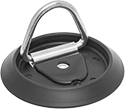Filter by
Movement
Ring Style
Base Material
Ring Material
Load Securement Type
Mounting Hole Center-to-Center Length
Mounting Screw Size
Base Color
Weight Capacity
Anchor Point Type
Ring Thickness
Base Width
Ring Height
Ring Finish
Base Diameter
Number of Mounting Holes
Export Control Classification Number (ECCN)
REACH
Base Length
DFARS Specialty Metals
RoHS
Number of Rings
Tie-Down Rings
 |
Style D |
These rings pivot to secure loads in various directions.
Warning: Never use for lifting applications.
Zinc-Plated Steel—Zinc-plated steel rings have mild corrosion resistance.
Ring | Base | Mounting Holes | Each | ||||||||||||||||||||||||||||||||||||||||||||||||||||||||||||||||||||||||||||||||||||||||||||||||
|---|---|---|---|---|---|---|---|---|---|---|---|---|---|---|---|---|---|---|---|---|---|---|---|---|---|---|---|---|---|---|---|---|---|---|---|---|---|---|---|---|---|---|---|---|---|---|---|---|---|---|---|---|---|---|---|---|---|---|---|---|---|---|---|---|---|---|---|---|---|---|---|---|---|---|---|---|---|---|---|---|---|---|---|---|---|---|---|---|---|---|---|---|---|---|---|---|---|---|---|
Style | Wt. Cap., lb. | Inner Wd. | Ht. | Thk. | Style | Dia. | Material | Mounting Fasteners Included | No. of | Dia. | Ctr.-to-Ctr. Lg. | For Mounting Screw Size | 1-99 | 100-Up | |||||||||||||||||||||||||||||||||||||||||||||||||||||||||||||||||||||||||||||||||||||
Zinc-Plated Steel | |||||||||||||||||||||||||||||||||||||||||||||||||||||||||||||||||||||||||||||||||||||||||||||||||||
| D | 500 | 2" | 2 1/4" | 1/4" | D-Ring | 4 1/16" | Polypropylene | No | 3 | 9/32", 13/32" | 1 3/16" | 3/8" | 3076T12 | 00000 | 00000 | ||||||||||||||||||||||||||||||||||||||||||||||||||||||||||||||||||||||||||||||||||||
Adhesive-Back Tie-Down Rings
 |
Create an anchor point without drilling or welding—adhesive on the back holds this ring in place. The flexible foam rubber base mounts to curved surfaces and adheres to glass, metal, and plastic.
Warning: Never use for lifting applications.
Ring | Base | ||||||||||||||||||||||||||||||||||||||||||||||||||||||||||||||||||||||||||||||||||||||||||||||||||
|---|---|---|---|---|---|---|---|---|---|---|---|---|---|---|---|---|---|---|---|---|---|---|---|---|---|---|---|---|---|---|---|---|---|---|---|---|---|---|---|---|---|---|---|---|---|---|---|---|---|---|---|---|---|---|---|---|---|---|---|---|---|---|---|---|---|---|---|---|---|---|---|---|---|---|---|---|---|---|---|---|---|---|---|---|---|---|---|---|---|---|---|---|---|---|---|---|---|---|---|
Wt. Cap., lb. | Inner Wd. | Style | Lg. | Wd. | Material | Adhesive Type | Reaches Full Strength, hr. | Begins to Harden, min. | Temp. Range, ° F | Each | |||||||||||||||||||||||||||||||||||||||||||||||||||||||||||||||||||||||||||||||||||||||||
Polyethylene Rope | |||||||||||||||||||||||||||||||||||||||||||||||||||||||||||||||||||||||||||||||||||||||||||||||||||
| 140 | 2 1/2" | D-Ring | 3 1/8" | 2 1/2" | EVA Foam | Acrylic | 72 | 20 | -95 to 165 | 8310T13 | 000000 | ||||||||||||||||||||||||||||||||||||||||||||||||||||||||||||||||||||||||||||||||||||||||

























